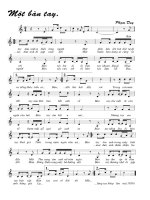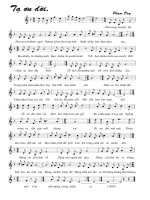Duy lợi english.
Bạn đang xem bản rút gọn của tài liệu. Xem và tải ngay bản đầy đủ của tài liệu tại đây (945.13 KB, 4 trang )
60
Duy Loi
foldable hammock
60
- Innovative ideas, plus effective means to appropriate the ideas.
- Obtaining appropriate legal services which allow the designated law firm to win law suits in overseas
countries, therefore opening up the export market.
Success factors
Duy Loi foldable hammock
Entrepreneur/ Overcoming Poverty through Enterprise
PDF created with pdfFactory trial version www.pdffactory.com
I
n the late 1980s and early 1990s, as a worker in a
state-run mechanics enterprise, Mr. Loi lived in very
difficult conditions, receiving only a low income. One day,
a neighbor asked him to fix a hammock which had a
metal-supported structure. Mr. Loi modified the structure,
making it foldable so that it was easier to use and carry.
Positive feedback from his neighbor convinced Mr. Loi of
the potential market for his idea.
Excited with his new idea, he made some prototypes which
were very much enjoyed by voluntary users. He discussed
the idea of launching this new product with his manager at
the state-owned enterprise (SOE), as a profit-sharing
arrangement between Mr. Loi and the SOE. After
cooperating with the SOE for a short time, the deal turned
out to be problematic. He decided to quit his job at the
SOE and set up his own production unit to make and
market the foldable hammocks.
Making hammocks and supporting structures with
traditional materials (wood and steel rather than high-tech
material) does not require any sophisticated technology
and/or huge investment. Literally, any one with small
amounts of capital and a fair knowledge of mechanics
could set up a workshop to make hammocks. However,
what makes Mr. Loi's hammock business different from
others is that he has had the innovative idea of creating a
foldable frame. Traditional hammocks do not have any
supporting structure at all. The two tails are tied to any two
fixed objects - be they trees, pillars or metal rings fixed on
to walls. With a foldable frame (made of metal or wood),
the hammock can be set up anywhere without having to
consider the supporting points.
An even greater advantage is that Mr Loi has been able to
protect his idea by means of Intellectual Property Rights
(IPR) legislation. As a mechanic, he knew very well that
his idea of a foldable frame could easily be copied once it
was exposed to the market. He therefore applied to patent
his designs in Vietnam quite early in the progress of his
business, before he started any mass production. His first
application was recognized by the Department of IPR in
Vietnam on 23 March 2000 and he was granted a patent for
his design shortly afterwards. This move turned out to be
vital for his business, given later developments.
Success with the patenting of his product in Vietnam gave
Mr. Loi more confidence to start mass production. Right
from the start, in 2000, given its highly portable capability
(foldable and weighing only 7 kg), Duy Loi foldable
hammocks quickly became dominant in the Southern
market. The market was quickly expanded in 2001 and
2002. He also started to export, mainly to the United States
(US), Japan, South Korea and Australia.
Following his success during these years, in 2002, Duy Loi
successfully signed a supplying contract with Keyio, an
international Japanese supermarket chain. However, at the
height of his business success, a threat emerged that
promised to block this promising contract. In August 2002,
Duy Loi received a letter from a lawyer representing a
Japanese
61
Entrepreneur/ Overcoming Poverty through Enterprise
PDF created with pdfFactory trial version www.pdffactory.com
company requiring that Duy Loi had to
either stop exporting its foldable
hammock to Japan or pay a royalty of $4
per hammock. The Japanese firm argued
that the Duy Loi foldable hammock had
violated its patent (Number 3081528) on a
similar structure which was granted by
the Japanese Patent Office on 22 August
2001.
Confronted with this challenge, Mr. Loi
decided to seek support from a law firm, a
very rare move for a small to medium
enterprise (SME) in Vietnam. He
discussed his situation with Pham &
Associates, a law firm with a
specialization in this field, and became
convinced that, given that the patent for
his design was recognized by the
Vietnamese IPR authorities on 23 March
2000, much earlier than the date of issue
of the Japanese patent, he had a chance to
file a suit against the Japanese firm and so
protect his business. Pham & Associates
were assigned as representatives for Duy
Loi in this process. In November 2002,
Duy Loi formally sent a letter to the
Japanese Patent Office requiring the
Office to withdraw the patent granted to
the Japanese firm since the invention
described in this patent was similar to the
Duy Loi structure which had been
exposed to the public much earlier. Given
the solid arguments and evidence for his
case, after six months of the suit the
Japanese Patent Office withdrew Patent
3081528, opening the way for Duy Loi to
export to the Japanese market.
The Japan experience make Duy Loi more
careful about IPR issues, especially when
the company expanded its overseas
market. Through searching the US patent
database, Pham & Associates found a
patent filed on 23 March 2001, granted by
the US Patent Office to a Taiwanese
businessman for his inventive idea of a
foldable hammock. It is obvious that the
structure shown in this patent is very
similar to that of Duy Loi's hammock.
Given that this patent was filed much later
than the day the Duy Loi structure was
released to the public, Duy Loi decided to
bring a suit against the Taiwanese
businessman for violating US patent law.
If successful with this suit, Duy Loi can
avoid being accused of violating IPR, and
means the company can freely export to
the US market.
The two law suits have turned Duy Loi
into a very well-known firm in Vietnam.
To some extent, this has helped to sell
their products in the domestic market.
However, it has not been easy for the firm
to develop its market domestically.
Although Duy Loi has won the market in
the South, the Northern market (Ha Noi in
particular) has not developed to the extent
Mr. Loi desires. The only product that
sells well in Ha Noi is the hammock for
children. Mr. Loi explained that people in
Ha Noi regard the hammock as something
belonging to the countryside - something
which is no longer suitable for modern
houses. This sense of what is suitable for
modernization has been an emerging
trend in recent times. Another difficulty is
that Duy Loi also has many competitors.
Some of them obviously copy the Duy Loi
design, but given the week enforcement
of IPR law in Vietnam, it is very costly to
prevent this. Other producers have
modified their design to avoid violating
IPR law, and these producers compete
directly with Duy Loi.
Besides the main product line, the
company also produces other foldable
objects - notably chairs and beds - using
a variety of materials and designs. The
company now owns seven patents for
inventions/utility models and one patent
for industrial design related to its
products.
Mr. Loi's management style is modest. He
works in a simple office located right in
the workshop. There is a large design
table in the office where he develops most
of his designs with a simple calculator. He
describes himself as the manager,
designer and technician of the company
and is very proud of the compact
organizational form of the company. It is
very obvious that he hates the old hard
days of complex but ineffective
administration of SOEs and that he tries
his best not to emulate this with his own
company.
From a family size workshop with a few
workers, Duy Loi has developed into a
well-known firm with about 70 workers at
the present time (early 2005). The
company sells several tens of thousands
of products per year, of which 30% are
exported. It has 200 distribution agents in
Vietnam and they also function as the
main marketing channels. Its local
markets are mainly in HCMC and
Southern provinces. The Northern market
is under development and has so far not
been very successful. The company
exports to many countries, including
Japan and the US.
62
Entrepreneur/ Overcoming Poverty through Enterprise
PDF created with pdfFactory trial version www.pdffactory.com
63
Entrepreneur/ Overcoming Poverty through Enterprise
Success factors
- Innovative ideas, plus effective means to
appropriate the ideas.
- Obtaining appropriate legal
services which allow the designated law firm to win
law suits in overseas
countries, therefore opening up the export market.
PDF created with pdfFactory trial version www.pdffactory.com









